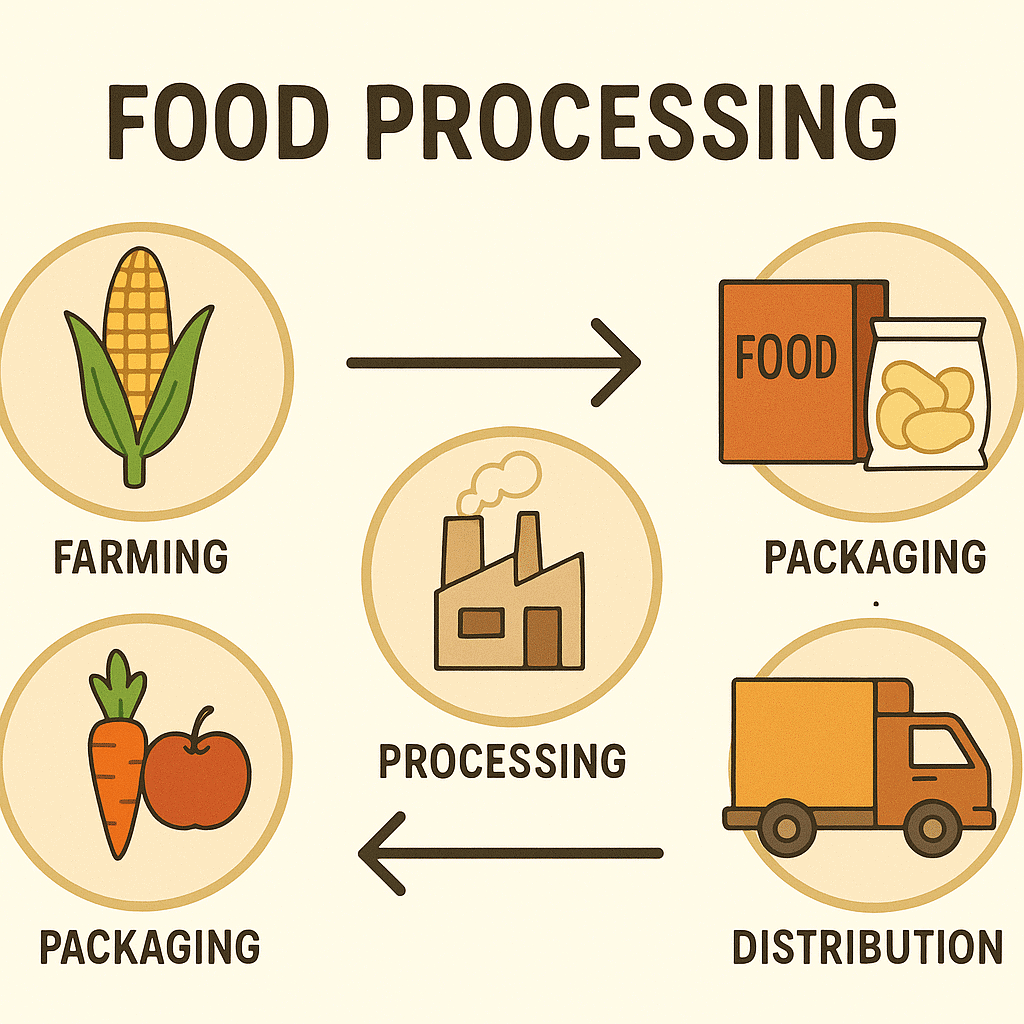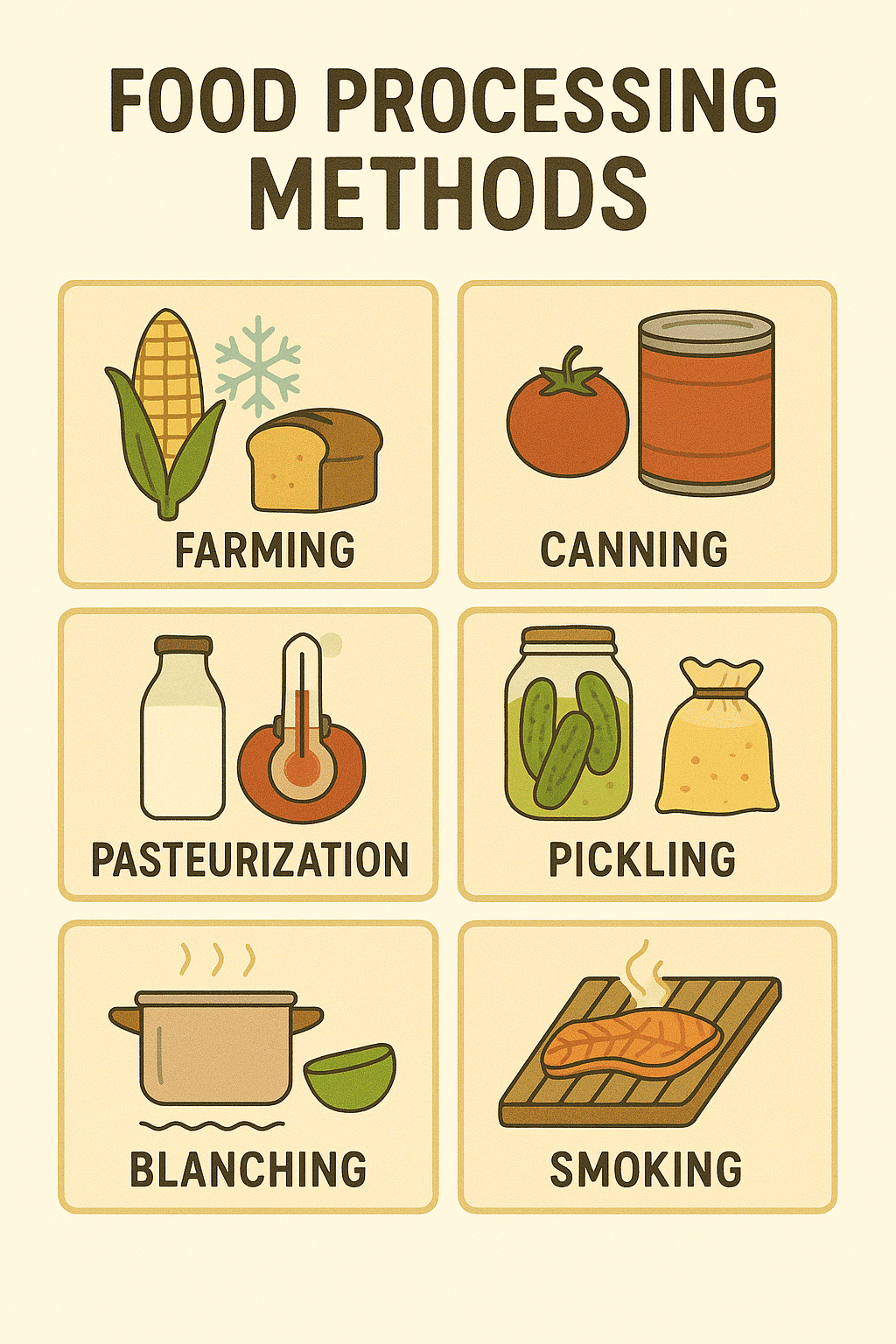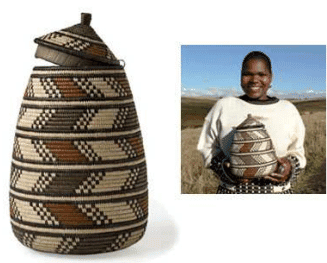Food Processing Chapter Notes | Natural Science and Technology (Grade 6-A) PDF Download
| Table of contents |

|
| Why Do We Need Food Processing? |

|
| How Are Foods Processed? |

|
| Food Processing Methods |

|
| Points to Remember |

|
| Difficult Words |

|
| Summary |

|
Why Do We Need Food Processing?
Food processing involves preparing, preserving, or altering food to make it edible, last longer, or improve its nutritional value. For thousands of years, people have processed food to ensure a steady supply, especially during times when fresh food was scarce, such as winter. Before modern refrigeration, methods like curing—salting, spicing, and drying meat or fish—were used to preserve food. In South Africa, examples include biltong (dried meat) and bokkoms (cured fish).

Food Processing - Then and Now
Long ago, people processed food to survive seasonal shortages. Explorers, like Columbus and Vasco da Gama, relied on preserved foods during long voyages. These methods ensured food was available when fresh supplies were not.Benefits of Food Processing
Food processing offers several advantages in modern life:
- Easier Transportation: Processing makes delicate foods, like grapes or strawberries, easier to transport by preserving them, extending their shelf life.
- Year-Round Availability: Modern processing and transportation allow access to fruits and vegetables regardless of season, supporting a balanced diet.
- Nutritional Enhancement: Some foods are fortified with extra vitamins and nutrients, or processed to improve nutritional value, such as fermenting dairy into yogurt or cheese.
- Convenience: Processed foods are quicker and easier to prepare, saving time.
- Dietary Needs: Processing enables people with allergies (e.g., milk allergies) or conditions like diabetes to access suitable foods, such as rice or soya milk.
- Preservation: Processing, like making jam or pickling onions, prevents spoilage and extends usability.
Drawbacks of Food Processing
While beneficial, over-processed foods can have disadvantages:
- Nutrient Loss: Processing may reduce the natural nutrient content of foods.
- Additives: Highly processed foods often contain additives like sugar, salt, or preservatives, which may affect health if consumed excessively.
- Health Concerns: Some believe highly processed foods contribute to health issues due to reduced nutritional value or harmful additives.
How Are Foods Processed?
Food processing varies by the degree of alteration from the raw product to the final form. Foods are categorized into minimally processed, processed food ingredients, and highly processed foods, each involving different methods to achieve preservation, edibility, or enhanced value.
Levels of Food Processing
- Minimally Processed Foods: These undergo slight changes from their natural state, such as harvesting, washing, peeling, chopping, juicing, or removing inedible parts. Examples include fresh fruits, vegetables, nuts, meat, and milk. They have a short shelf life.
- Processed Food Ingredients: These are significantly altered, no longer resembling the original product, and have a longer shelf life. Examples include flours, oils, fats, sugars, syrups, margarine, sweeteners, and starches. Processing often reduces nutrients, so manufacturers may add vitamins or minerals.
- Highly Processed Foods: These are extensively transformed and include snack foods, desserts, biscuits, cereal bars, chips, cakes, pastries, soft drinks, breads, pastas, breakfast cereals, infant formula, and processed meats (e.g., sausages, polony, fish fingers). They often contain additives and have a long shelf life.
Example of Processing Stages
The transformation of wheat illustrates the levels of processing:
- Raw Product: Wheat kernels.
- Processed Ingredient: Flour, ground from wheat.
- Highly Processed Food: Bread, made from flour and other ingredients.
Food Processing Methods
Various methods, both traditional and modern, are used to process food:- Sun Drying: Drying food, like the Ndebele’s Umrorha plant, in the sun to preserve it for winter.
- Fermenting: Converting dairy into cheese, buttermilk (Amasi), or yogurt, or fermenting barley or grapes for beer.
- Pickling: Preserving vegetables, like onions or gherkins, in vinegar or brine.
- Salting and Spicing: Adding salt and spices to meat or fish, then drying it, as in biltong or bokkoms.
- Adding Sugar: Preserving berries or fruits as jams or preserves.
- Pasteurisation: Heating milk or juice to a specific temperature to kill bacteria and extend shelf life.
- Cooking: Roasting, smoking, baking, or frying to make food edible or preserve it.
- Toasting: Heating to enhance flavor and preserve foods like nuts or grains.
- Freezing or Refrigerating: Cooling foods to slow spoilage.
- Freeze Drying: Removing water from frozen food to preserve it.
- Spray Drying: Turning liquids into powders, like milk powder.
- Making Juice Concentrates: Reducing juice to a concentrated form for storage.

Performance Parameters in Food Processing
All food processing methods must adhere to five key standards:- Hygiene: Ensuring food is free from bacteria and germs.
- Energy Efficiency: Using minimal energy to process food.
- Minimal Wastage: Reducing food loss during processing.
- Labour Efficiency: Streamlining processes to save time and effort.
- Minimal Factory Shutdowns: Keeping production consistent to meet demand.
Traditional Food Processing Example:
In Zulu culture, beer (utshwala) is traditionally made by women using sorghum and maize. The process involves soaking, boiling, mashing, cooling, and filtering the mixture through a palm-frond sieve. The beer is fermented in a semi-thatched hut for oxygen supply and served in clay vessels (imbiza, iphangela, ukhamba). This 3% alcohol beer is nutritious, made without modern additives.

Points to Remember
- The Ndebele people dry the Umrorha plant in the sun to store it for winter, a traditional preservation method.
- Food processing makes food edible (e.g., cooking), preserves it (e.g., drying), or improves nutrition (e.g., fermenting dairy).
- Processing enables year-round access to fruits and vegetables, supporting a balanced diet.
- Minimally processed foods, like fresh vegetables, undergo little change and have a short shelf life.
- Processed food ingredients, like flour or sugar, are altered significantly and may lose nutrients.
- Highly processed foods, like chips or sausages, contain additives and have a long shelf life.
- Food processing methods include drying, fermenting, pickling, salting, pasteurisation, and freezing.
- Hygiene, energy efficiency, minimal wastage, labour efficiency, and minimal factory shutdowns are critical in food processing.
- Traditional methods, like Zulu beer making, use natural materials and processes to preserve and prepare food.
Difficult Words
- Food Processing: Changing raw food to make it edible, preserve it, or enhance its nutritional value.
- Preserving: Processing food to make it last longer, like drying or pickling.
- Curing: Preserving meat or fish by salting, spicing, and drying, as in biltong or bokkoms.
- Fermenting: A process where microorganisms transform food, like turning milk into yogurt or grapes into beer.
- Pickling: Preserving food in vinegar or brine, like pickled gherkins.
- Pasteurisation: Heating food, like milk, to kill bacteria and extend shelf life.
- Minimally Processed: Foods with slight changes, like washed vegetables, that retain their natural form.
- Highly Processed: Foods extensively altered, like chips or sausages, often with additives.
- Nutritional Value: The health benefits provided by nutrients in food.
- Additives: Substances like sugar or preservatives added to processed foods to enhance flavor or shelf life.
- Hygiene: Cleanliness in food processing to prevent contamination by bacteria or germs.
Summary
Food processing transforms raw food to make it edible, preserve it, or improve its nutritional value, a practice used for thousands of years to ensure food availability. Methods like curing, drying, fermenting, pickling, pasteurisation, and freezing help preserve foods like biltong, yogurt, or jam. Processing enables year-round access to diverse foods, supports dietary needs, and adds convenience, but over-processing can reduce nutrients or add unhealthy additives. Foods range from minimally processed (e.g., fresh vegetables) to highly processed (e.g., chips), with methods adhering to standards like hygiene and efficiency. Traditional practices, like Zulu beer making, highlight the cultural significance of food processing, which remains essential for a balanced diet and modern food systems.
FAQs on Food Processing Chapter Notes - Natural Science and Technology (Grade 6-A)
| 1. Why is food processing important ? |  |
| 2. What are some common food processing methods ? |  |
| 3. How does food processing help in preserving nutrients ? |  |
| 4. What are the benefits of processed foods ? |  |
| 5. Are there any disadvantages to food processing ? |  |















